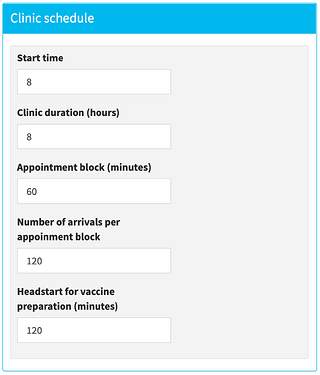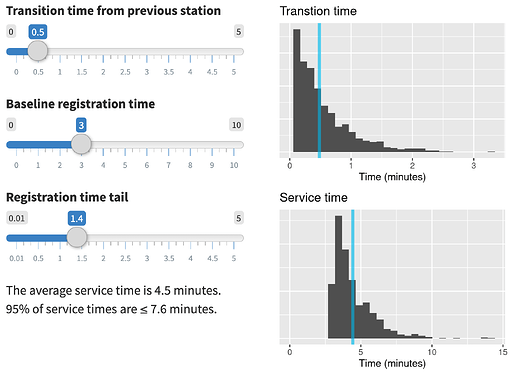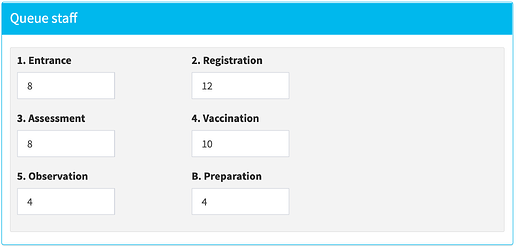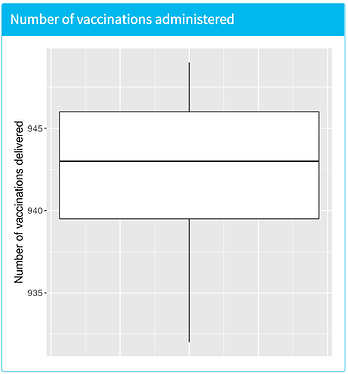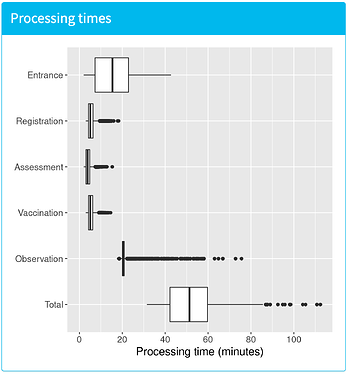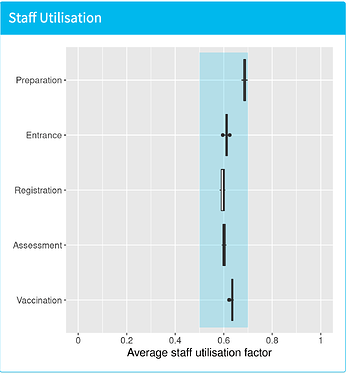Vaccine Queue Simulator
Authors: Mark Hanly; Oisín Fitzgerald; Tim Churches
Abstract: As COVID-19 immunisation programs are rolled out internationally, this app supports users to plan mass vaccination clinics. Using queue network simulations, you can balance health system capacity (e.g. staff numbers) to maximise queue performance (e.g. daily throughput).
Full Description: # Vaccine Queue Simulator
Overview
With this app you can use mathematical simulations of waiting in line, known as stochastic queue network models, to model the process of running a vaccination clinic.
Queue models make it possible to assess the daily vaccination capacity for different venues, taking into account available staff numbers and estimated times to complete each stage of the vaccination process.
The queue network models implemented here use the R package queuecomputer.
Queueing Models
Mass vaccination hubs and GP clinics lay out their vaccine clinics differently. Hubs with larger premises and more staff can adopt an assembly line approach to vaccination. They can divide the tasks of registration, clinical assessment, vaccine preparation and administration across a series of stations. Smaller clinics are likely to have fewer people available, each performing multiple tasks. We developed two distinct network models to reflect these different set-ups.
1. Mass vaccination hubs
A mass vaccination hub can be set up as an assembly line and requires a large space such as a sports arena or conference centre.
2. General practice clinics
Staff at a general practice clinic would have to perform more tasks.
Model Inputs (Health system capacity)
Once you choose the appropriate queue network, the model requires three key inputs:
- Appointments and arrivals
- Service times
- Staff numbers
1. Appoinments and arrivals
Specify the details of clinic duration, appoinment slots and frequency of arrivals.
2. Service times
Specify the estiamted amount of time for completing each stage of the queue.
3. Staff numbers
Specify how many staff are available at each stage of the queue.
Model outputs (Queue performance)
Queue performace is summarised with three primary metrics:
- Total daily throughput
- Processing times
- Staff utilisation
1. Daily throughput
How many people can be vaccinated over the course of a clinic?
2. Processing times
What is the total waiting time and the waiting time for each station? Are there any bottlenecks?
3. Staff utilisation
How busy are the staff? Once staff utilisation exceeds 80% queue performance diminishes rapidly.
Summary
As countries around the world roll out their COVID-19 vaccination programs, this app can be used to inform service delivery at mass vaccination hubs and GP clinics.
Keywords: Queue network modelling, vaccination, public health, queuecomputer R package
Shiny app: https://cbdrh.shinyapps.io/queueSim/
Repo: GitHub - CBDRH/vaccineQueueNetworks: Shiny interface to mass vaccination and GP clinic queueing models
RStudio Cloud: Posit Cloud
Thumbnail:

Full image:


